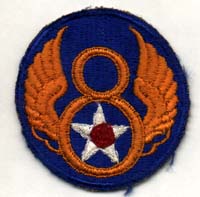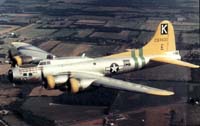 |
 |
 |
The USAAF in wartime Britain
In January 1942 the USAAF was made up of four separate air forces, located in different regions of the USA and designated the First to Fourth. On January 2nd the Fifth Air Force was inaugurated but within days was re-designated the Eighth Air Force as plans were drawn up for engagement in hostilities on a world wide basis. It was eventually decided that the infant Eighth would form the nucleus of a build up of forces in the UK. In February 1942 a small advance party set up HQ in High Wycombe at Daws Hill Lodge.
The USAAF believed in the importance of strategic air bombardment as a war-winning concept. It was to be carried out in daylight by a planned 60 combat groups made up of 33 heavy, medium or light bombardment groups, 12 fighter groups for air cover and 15 observation or transport groups.
In July 1942 the first American B17 bombers and P38 fighters and crews arrived in Britain and by mid 1944 the Eighth Air Force had grown to become the biggest military air fleet ever seen. By this time, it had 122 bases, 200,000 personnel, 2,000 four engined bombers and 1,000 fighters.
At first, the bomb groups were divided into the First and Second Wings. By October 1942 there was also a Third and Fourth Bombardment Wing. By June 1944 The Eighth US Army Air Force heavy bombardment groups were split into three air divisions.
The 1st Air Division covered Cambridgeshire and Northamptonshire. Their aircraft were identified by a triangle on the tail. |
 |
Aeroplane Markings. Planes of the 3rd Air Division carried a square on the tail. The tail plane markings of triangle, circle and square were used on their own from 1942 to 1944. They contained identification letters denoting the Group. For example a square with an A was the 94th from Rougham, a B was the 95th from Horham and C was the 96th out of Snetterton. K in a square represented the 447th at Rattlesden. These markings were extended in 1944 by coloured bands on the tail and stripes and chevrons on the wings, in an attempt to improve identification over longer distances. As a general rule a squadron was made up of around 10 to 12 planes. There were normally 4 squadrons in a Bomb Group. A bomb group was usually based on one home airfield, although there were cases like the 388th at Knettishall who had a satellite station at Fersfield in Norfolk. Three Bomb Groups made up a Combat Wing and an Air Division could grow to around six or seven wings. |
| Reference books consulted | |
|---|---|
| The Mighty Eighth | Roger Freeman |
| Memories of the Eighth | George H Fox |
| Action Stations East Anglia | Michael Bowyer |
| Historical Highlights USAFE | Snyder and Harrington |
Most of the information on The Mighty Eighth
was supplied by Ernest Osborne and adapted
for the St Edmundsbury website by
David Addy in 1997.
| Go to American Connections | Updated 8 April 2006 | Go to Home Page |